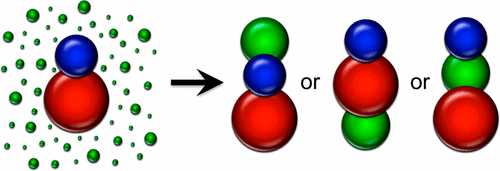当前位置:
X-MOL 学术
›
Acc. Chem. Res.
›
论文详情
Our official English website, www.x-mol.net, welcomes your feedback! (Note: you will need to create a separate account there.)
Controlling Configurational Isomerism in Three-Component Colloidal Hybrid Nanoparticles
Accounts of Chemical Research ( IF 18.3 ) Pub Date : 2017-05-18 00:00:00 , DOI: 10.1021/acs.accounts.7b00105 James M. Hodges 1 , Raymond E. Schaak 1
Accounts of Chemical Research ( IF 18.3 ) Pub Date : 2017-05-18 00:00:00 , DOI: 10.1021/acs.accounts.7b00105 James M. Hodges 1 , Raymond E. Schaak 1
Affiliation

|
Colloidal hybrid nanoparticles are solution-dispersible constructs that join together multiple distinct nanoscale materials through direct solid–solid interfaces. Given their multifunctionality and synergistic properties that emerge from interfacial coupling, hybrid nanoparticles are of interest for applications in biomedical imaging, solar energy conversion, heterogeneous catalysis, nanophotonics, and beyond. High-order hybrid nanoparticles, which incorporate three or more nanocrystal domains, offer greater tunability and functional diversity relative to one or two-component nanoparticles. The multiple heterojunctions within these structures can facilitate complex electromagnetic coupling as well as cooperative surface processes. Additionally, these materials can be used as model systems for studying fundamental structure–property relationships at the nanoscale that arise from particle coupling and interfacial exchanges. Limiting these advances is the inability to synthesize hybrid nanoparticles with precise morphologies and geometries. High-order hybrid nanoparticles can adopt more than one configuration, and each unique arrangement will have different heterointerfaces and, accordingly, different functions. Seeded-growth methods are among the most effective methods for producing high-quality hybrid nanoparticles. Engineering complex heterostructures using these stepwise reactions is in some ways conceptually analogous to the total synthesis of large organic molecules. However, unlike in molecular synthesis, the rules and guidelines that underpin the formation of hybrid nanoparticles are less understood. For example, when a third domain is added to a two-component heterodimer nanoparticle seed, several distinct types of hybrid nanoparticle products are possible, but only one is typically observed due to preferred growth at specific locations. The three-component heterotrimer products that preferentially form are not necessarily those that have the domain configurations and heterojunctions required to facilitate a targeted application. Different arrangements of the three nanoparticles that comprise a heterotrimer lead to distinct configurational isomers. Accordingly, understanding and controlling configurational isomerism in nanoparticle heterotrimers is foundational for engineering high-order hybrid nanostructures with targeted heterointerfaces, properties, and functionalities.
中文翻译:

控制三组分胶体杂化纳米颗粒中的构型异构现象。
胶体杂化纳米颗粒是溶液可分散的结构,通过直接的固-固界面将多种不同的纳米级材料连接在一起。鉴于其从界面偶联中产生的多功能性和协同特性,杂化纳米颗粒在生物医学成像,太阳能转换,非均相催化,纳米光子学及其他领域中的应用引起了人们的兴趣。相对于一种或两种组分的纳米颗粒,结合了三个或更多纳米晶体域的高阶杂化纳米颗粒提供了更大的可调性和功能多样性。这些结构中的多个异质结可以促进复杂的电磁耦合以及协作的表面过程。此外,这些材料可以用作模型系统,以研究由于粒子耦合和界面交换而产生的纳米尺度的基本结构与属性之间的关系。限制这些进展的原因是无法合成具有精确形态和几何形状的杂化纳米颗粒。高阶杂化纳米粒子可以采用多种配置,并且每种独特的排列将具有不同的异质界面,因此具有不同的功能。种子生长方法是生产高质量杂化纳米颗粒的最有效方法之一。在某些方面,使用这些逐步反应工程化复杂的异质结构在概念上类似于大型有机分子的总合成。但是,与分子合成不同,支撑杂化纳米颗粒形成的规则和指南鲜为人知。例如,当将第三结构域添加到两组分异二聚体纳米颗粒种子中时,几种不同类型的杂化纳米颗粒产物是可能的,但是由于在特定位置的优选生长,通常仅观察到一种。优先形成的三组分异三聚体产物不一定是那些具有促进目标应用所需的结构域配置和异质结的产物。包含异三聚体的三个纳米颗粒的不同排列导致不同的构型异构体。因此,了解和控制纳米异质三聚体中的构型异构现象是工程化具有目标异质界面的高阶杂化纳米结构的基础,
更新日期:2017-05-18
中文翻译:

控制三组分胶体杂化纳米颗粒中的构型异构现象。
胶体杂化纳米颗粒是溶液可分散的结构,通过直接的固-固界面将多种不同的纳米级材料连接在一起。鉴于其从界面偶联中产生的多功能性和协同特性,杂化纳米颗粒在生物医学成像,太阳能转换,非均相催化,纳米光子学及其他领域中的应用引起了人们的兴趣。相对于一种或两种组分的纳米颗粒,结合了三个或更多纳米晶体域的高阶杂化纳米颗粒提供了更大的可调性和功能多样性。这些结构中的多个异质结可以促进复杂的电磁耦合以及协作的表面过程。此外,这些材料可以用作模型系统,以研究由于粒子耦合和界面交换而产生的纳米尺度的基本结构与属性之间的关系。限制这些进展的原因是无法合成具有精确形态和几何形状的杂化纳米颗粒。高阶杂化纳米粒子可以采用多种配置,并且每种独特的排列将具有不同的异质界面,因此具有不同的功能。种子生长方法是生产高质量杂化纳米颗粒的最有效方法之一。在某些方面,使用这些逐步反应工程化复杂的异质结构在概念上类似于大型有机分子的总合成。但是,与分子合成不同,支撑杂化纳米颗粒形成的规则和指南鲜为人知。例如,当将第三结构域添加到两组分异二聚体纳米颗粒种子中时,几种不同类型的杂化纳米颗粒产物是可能的,但是由于在特定位置的优选生长,通常仅观察到一种。优先形成的三组分异三聚体产物不一定是那些具有促进目标应用所需的结构域配置和异质结的产物。包含异三聚体的三个纳米颗粒的不同排列导致不同的构型异构体。因此,了解和控制纳米异质三聚体中的构型异构现象是工程化具有目标异质界面的高阶杂化纳米结构的基础,


























 京公网安备 11010802027423号
京公网安备 11010802027423号